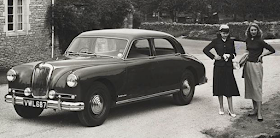He later moved to the Morris group where he designed the subjects of this post, the Riley Pathfinder, produced 1953-1957 (5,536 units built) and the Wolseley 6/90 produced 1954-1959 (11,852 units).
The bodies were nearly identical aside from their grilles. But the Riley was powered by a four cylinder motor whereas the Wolseley's engine had six cylinders, so this might be considered a marginal case of badge engineering.
The images below are factory sourced or are of cars listed for sale.
A 1955 Riley Pathfinder in this and the following two images. At its 1952 origin, the styling was dated by American standards, but modern in its British context. Aside from the prewar-style grille, the design features nothing but postwar elements, albeit in simple, conservative fashion. Fenders are of the slab, flow-through type. The windshield is of curved, one-piece glass. Headlights are mounted at the front of the fenders.
The rear window is large and also curved. The passenger greenhouse is nearly as wide as the car: note that the fender does not project very far from the beltline. The trunk (boot) lid has a simple shape. The tail light ensemble is dainty while the bumper is substantial.
Side view. A subtle touch is the fenderline. Starting at the B-pillar, it slightly rises and peaks above the rear axle line. Compare to the fenderline of an otherwise somewhat similar car in the following photo.
Here is a 1947 Frazer. It and its Kaiser stablemate were two of the earliest American cars with postwar styling (the other was the 1947 Studebaker). Here the fender is a flow-through slab, but is dropped farther below the beltline than the Riley's. The fenderline is simple, lacking the subtle curve that Palmer included. The passenger greenhouse is similar to the Riley's, though the windows are smaller and the windshield is formed by two pieces of flat glass. Palmer surely was aware of Kaiser-Frazer styling and might have been inspired by some of the features. However, his design is better proportioned, better shaped, more subtle and, in sum, more attractive.
A publicity photo of what is probably an early Pathfinder. It lacks the chrome trim along the fenderline seen in the previous images.
Side view of a 1957 Wolseley 6/90. The main differences from the Pathfinder are the chrome strip across the fender and door and the sculpted wheel opening surrounds.
Front quarter view. Front-end difference from the Riley include the grille, hood (bonnet) and bumper.
Seen from this perspective, we find a wider back window and different tail light assemblies.








wow this a amazing car collection for every car lover. you are awesome. I am impressed with this post. thanks for sharing with us Drivill
ReplyDelete
ReplyDeleteExtremely interesting post on what for Americans would be a very obscure car. I'd argue that the styling is more Italianate rather than American, this is one of the reasons the domineering Leonard Lord, Chairman, had Palmer pushed out of BMC as he disliked the look of the Riley/Wolseley. Similar styles can be seen in Lancia and Alfa Romeo of the era. Smaller cars in the BMC range were also influenced by these Palmer designs, the beautiful MG Magnette ZA/ZB and the Wolseley 4/44. Leonard Lord's antics were notorious and it was he who insisted on exporting the Austin Atlantic to the States with pitiful results, a car ill suited to American tastes & needs in the early 50s.
The Riley Pathfinder in particular was plagued by interference and delays in production and testing, some can argue this too was due to internal politicking in BMC between Lord Nuffield and Leonard Lord. The result being that early cars had unreliable rear axles and the car gained a reputation-unfairly really- for bad quality. The Wolseley was more conventional in its engineering and found favour as a Police car in the Britain of the 50s. Both cars were imposing by European standards, sleek and luxuriously trimmed, the Riley in particular. It is said to have been one of Lord Mountbatten's favourite cars. Palmer wanted Riley/MG/Wolseley to challenge & compete with Jaguar products, had the will and imagination been there from management this ambition could well have succeeded.
Alex G.
Alex -- Thank you for the information you provided. Can I assume you're from the UK? ... I always feel a bit ill at ease writing about non-American cars not imported here because I haven't "lived" them. For this post I had to rely on Palmer's autobiography and a Brooklands book containing road tests and such. So your background regarding the new BMC management situation is greatly appreciated.
ReplyDeleteDonald- Many thanks, your post is well supported and gives an excellent overview. I enjoyed it and it is useful for those car enthusiasts unfamiliar with these marques. I was born in Britain yes and as a small child these cars were still relatively familiar on the roads- despite their really rather small production numbers and British rust inducing climate. BMC is a complex entity, its demise from potential giant to embarrassment in the British Leyland years is an example of a catastrophic decline. If you compare how other European countries have managed and developed their auto industries- Germany, France, Italy, Czech Republic, Sweden the fate of BMC is terrible and sobering in comparison . Some potentially really great cars could have emerged from there, as it was there were mere flashes- flashes in the style of the Master of Darkness itself- Lucas.....
ReplyDeleteWarmest regards, Alex